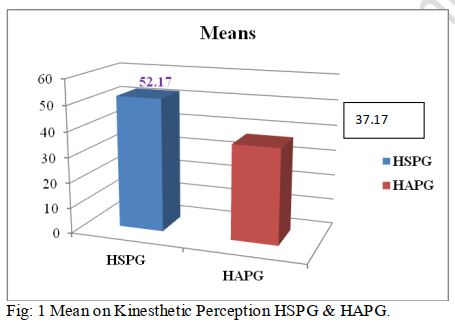COMPARATIVE STUDY OF KINESTHETIC PERCEPTION BETWEEN HIGH SPORTS PERFORMANCE AND HIGH ACADEMIC PERFORMANCE GROUPS
Abstract
The kind of sense organs found within the muscles and joints are called proprioceptors. The function of propioreceptors is conduct sensory reports to the central nervous system from muscles, tendons, ligaments and joints. These sense organs are concerned with kinesthetic senses that, in general, unconsciously tell us where our body part in relation to our environment. The objective of this study was to determine the difference of kinesthetic perception between high sports performance and high academic performance groups. In this research Total sixty (N=60) healthy teenagers boys were randomly selected as subjects for the present study from Maun Nath Bhanjan district of Uttar Pradesh. As Kinesthetic is the sense of position, location and orientation so, it was measured by kinesthetic obstacles test. The Independent t-test was used for the kinesthetic perception comparison of both groups. The level of significance was set at 0.05. The results showed the significant difference between HSPG & HAPG.
Downloads
References
Fox, L. Edward. Physiological Basis of Physical Education and Athletics (4th edition) publisher Wm. C. Brown Publisher.
Sarkar, S. & Sarkar, S.G. (Sept, 2013). Comparative Study on Kinesthetic Perception between High Academic Achievement Group and High Sports Performance Group. International Global Research Analysis, volume: 2
Brown, Jim. (March 19, 2013). All about Proprioception. Retrieved from http://www.coreperformance.com/knowledge/training/all-about-proprioception.html.
Johnson, Barry L. & Nelson, Jackson k. (1988) Practical Measurements for Evaluation in Physical Education (3rd Edition) Delhi; Surjeet Publication; pp: 225-228.
Hatzitaki V, Zisi V, Kollias I, Kioumourtzoglou E, (June 2002.) Perceptual-Motor Contributions to static and dynamic balance control in children as cited in the paper of Singh, Pramod & Debnat,h Subir on Relationship of Visual and Nonvisual Kinesthesis to the Performance of Perceptual Motor Skills.
Lynette, A. Jones (2000). Kinesthetic Sensing to appear in Human and Machine Hepatics, MIT Press. Retrieved from http://bdml.stanford.edu/twiki/pub/Haptics/PapersInProgress/jones00.pdf.
Andre, J. & Rogers S. (2006). Uses the verbal and blind-walking distance estimates to investigate the two visual system hypotheses Percept Psychophys.; 68(3):353-61
Kinesthetic learning (August 28, 2015). Retrieved on August 30, 2015 from the OLPC Wiki: https://en.wikipedia.org/wiki/Kinesthetic_learning.















